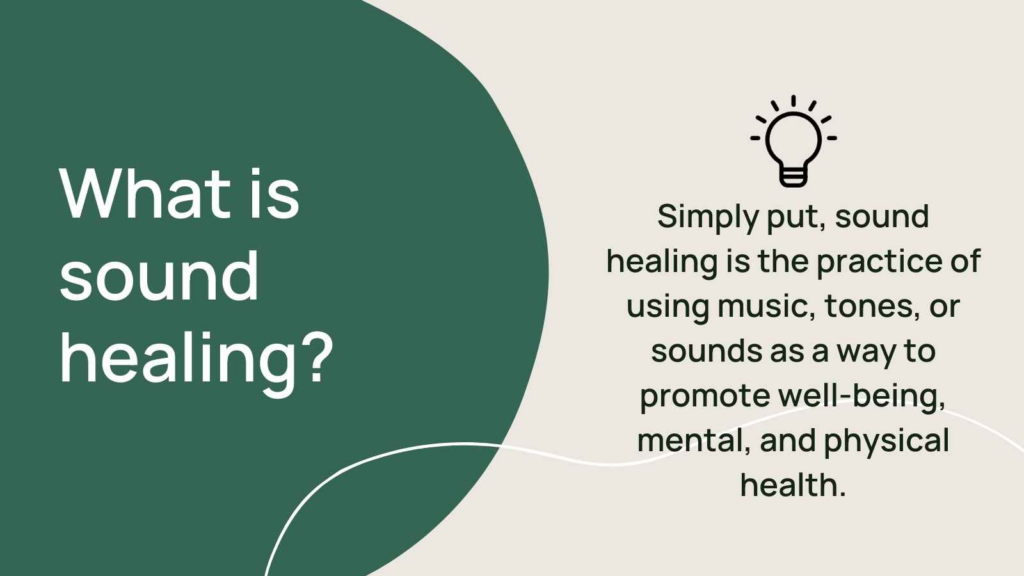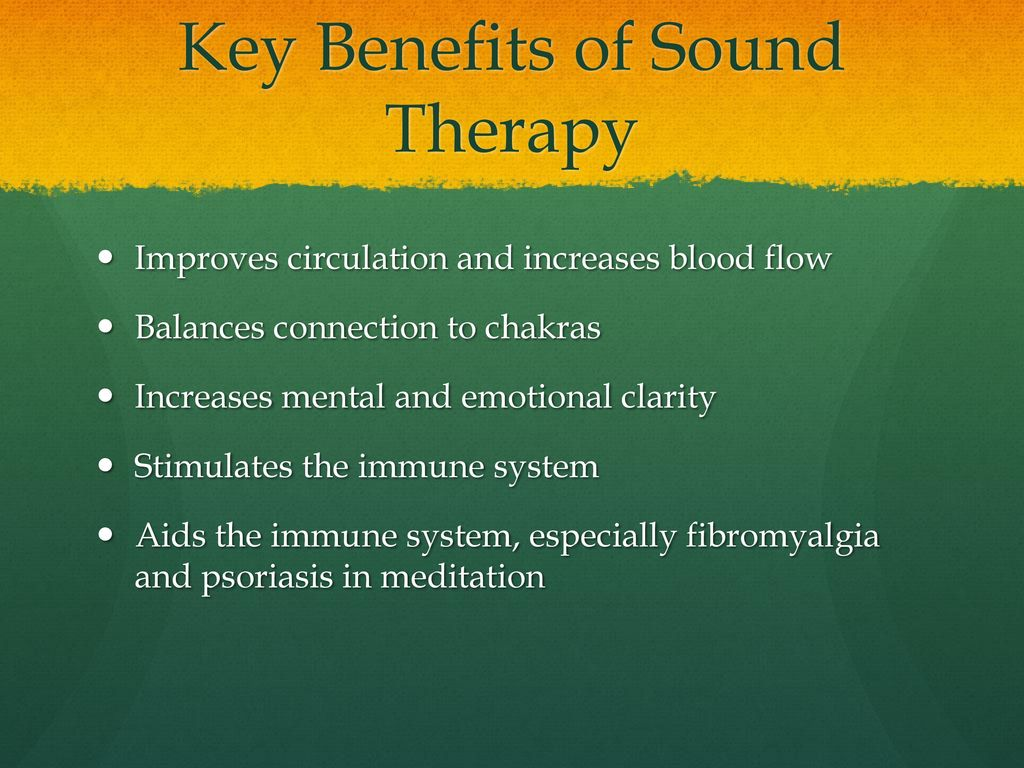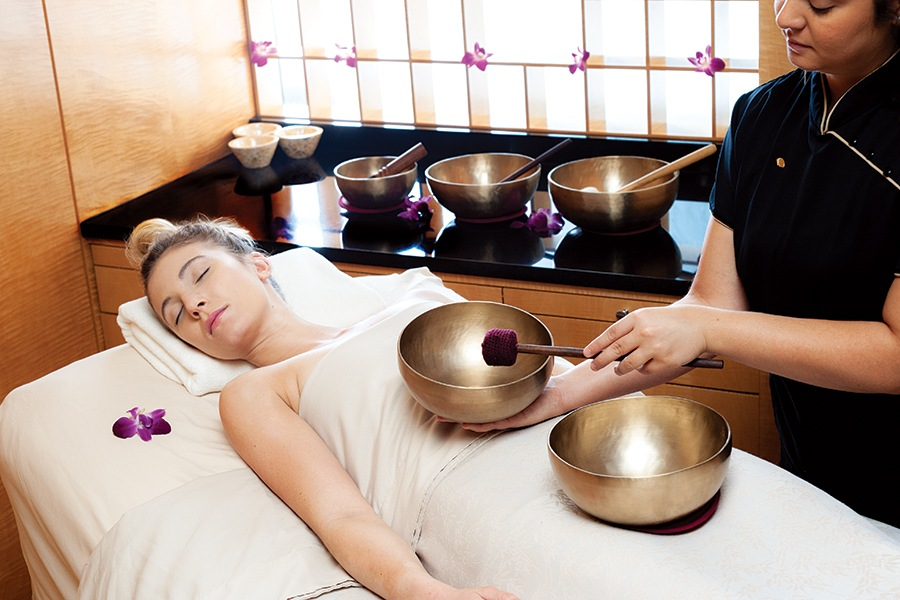Sound Therapy
Sound therapy is a captivating holistic healing method that uses sound to improve physical and mental wellness.

Ever thought of how sound can be used for healing? Reiki sound therapy combines an ancient technique known as Reiki with the healing aspects of vibrations from sound. This whole-body wellness system is aimed at harmonizing energies, reducing tension, and facilitating better health. Let’s see what this exceptional therapy is all about and some of its associated aspects.
What is Reiki Sound Therapy?
Reki sound therapy is an integrative practice that combines Reiki energy healing and sound therapy. Reiki involves a Japanese process where a practitioner channels universal life force energy through their hands to the client’s body.
Sound therapy on the other hand uses vibrations from instruments such as singing bowls, tuning forks, gongs, and others to stimulate the body’s innate healing capabilities. It thus unites these two practices by creating a strong positive influence that leads to perfect physical, emotional, and spiritual balance in individuals.
How to Do Sound Therapy on Yourself?
For self-sound therapy, you need high-quality headphones, a smartphone or computer for playing soundtracks, and optional tools like singing bowls or tuning forks. These tools help create a calming atmosphere, allowing you to immerse yourself in healing frequencies and maximize therapeutic benefits.
Here are some steps you may take:
- Select Your Instruments: Singing bowls or even a simple chime could be ideal.
- Make an Environment That Is Relaxing: Find a quiet place that you are comfortable in and where nobody will disrupt you.
- Set Goals: Think of what you want to achieve like relaxation, release, or balancing energy.
- Play the Instruments: Hit or play them while allowing vibrations to penetrate your body.
- Concentrate on Breathing: Take deep breaths so that sounds can lead you into meditation mode.
Which sound frequencies are good for beginners?
Beginners in sound therapy can start with Solfeggio frequencies like 396 Hz for grounding, 528 Hz for transformation, and 639 Hz for connection.
They are the most appropriate for any new practitioner since they will relax, bring emotional balance, and line up the energies of the body. It is also soft, yet effective, frequencies that allow the new user not to be overwhelmed with sensations when using the sound therapy.
Compared to other frequencies, the Solfeggio frequencies have been stated to instill a sense of peace and harmony in the body. With those, beginners can realize some immediate effects while being introduced to more complex techniques of sound therapy.

Are Sound Baths Spiritual?
Sound baths are often thought to have spiritual dimensions since they promote profound relaxation and connection to something larger than oneself.
Participants lay down while different types of instruments that emit sounds are played around them thereby creating a bath-like effect using waves of sounds. This kind of experience is capable of bringing about meditative state which may result into spiritual realization or emotional release.
How Long Should You Do Sound Therapy?
This duration allows the body and mind to relax and respond to the healing frequencies. Sessions can be adjusted based on individual needs, with shorter sessions of 15–20 minutes also providing benefits.
Some general advice regarding duration includes:
- Self-Practice: Maintaining healthiness through 10-20 minutes of daily relaxation
- Professional Sessions: These take approximately 45-90 minutes, allowing for more in-depth work on specific issues.
Sound Baths: They often last for about 30-60 minutes and offer a total body experience.

Why did I cry during my sound bath?
Crying is an obvious reaction that one can have during a Sound Bath and this might be an indication of emotional release. The vibrations produced from these instruments reach deep into the body unlocking suppressed emotions and healing. This is a normal process by which the body releases stress and trauma resulting in relief and clarity.
Can you fall asleep during a Sound Bath?
Yes, it’s alright to fall asleep while participating in a sound bath. The calmness of this experience can easily induce sleepiness on those who take part. By falling asleep one allows the healing vibrations to penetrate their body at subconscious level leading to improved health status among other things.
The Key Takeaway
Reiki sound therapy also provides an alternative approach to healing by merging energy transfer with sonic pulsation. Regardless of whether it’s done by a professional or practiced privately within someone’s premises, this endeavor comes with lots of advantages when it comes to one’s physical health, spiritual welfare, and emotional state. For those who want some new experiences related to their health then consider using Reiki sound therapy since its impact in your life will be beyond your comprehension.
Sound Therapy
Sound therapy is a captivating holistic healing method that uses sound to improve physical and mental wellness.

In a world where stress and pain are now so common, people have started looking towards holistic methods as a way of obtaining relief and improving their well-being. One such approach that has caught attention is sound therapy. However, many ask if sound therapy can heal the pain.
What Are The Different Types of Sound Therapy Techniques?
Different types of sound therapy techniques include sound baths, binaural beats, tuning fork therapy, Tibetan singing bowls, gong baths, and vocal toning, each with unique therapeutic benefits.
There are several types of sound healing with unique benefits and applications:
Sound Baths are immersive experiences where participants lie down to be “bathed” in the sound waves generated by different instruments. Common tools include gongs, Tibetan singing bowls, crystal singing bowls, etc.
The result is a complex fusion of frequencies overlapping each other to induce deep relaxation and reduce pain.
Binaural Beats occur when two slightly different frequencies are played on both ears creating an auditory illusion. The brain perceives it as a third tone which equals the difference between these two frequencies. This can promote specific brainwave patterns associated with either relaxation or focus.
Tuning fork therapy is about using specially calibrated metal forks that vibrate at certain frequencies. It is believed that the vibrations from tuning forks are essential in helping to realign the body’s energy field and thus promote healing.
Another powerful form of sound healing is through chanting and mantras. This practice has deep roots in many spiritual traditions.
How Does Sound Therapy Work?
Sound therapy works by using specific sound frequencies and vibrations to influence brainwave patterns, promote relaxation, reduce stress, and balance energy, enhancing overall well-being.

To understand how sound healing might affect pain, one needs to explore the science behind this practice.
In essence, sound therapy revolves around the idea that everything in existence vibrates. Different sound frequencies can alter our brain waves, causing different states of consciousness-
Delta waves (0.5-4 Hz) are associated with Somnolence, sleep, deep sleep, and coma. Theta waves (4-8 Hz) are linked to relaxation; and drowsiness. Alpha waves (8-13 Hz) are connected to calm alertness.
Beta waves (13–30 Hz) are related to active thinking, understanding new ideas;
By subjecting specific parts of the body to certain sound frequencies, practitioners aim at putting it into favorable brainwaves to reduce pain sensations.
What Is The Mind-Body In Sound Therapy?
The mind-body connection in sound therapy involves using sound to align mental and emotional states with physical well-being, promoting overall health through synchronized relaxation and energy balance.
Sound therapy exploits the strong relationship between our brains and bodies. Some sounds have the ability to stimulate the secretion of hormones and neurotransmitters that can affect our feelings about pain and emotions.
Sound therapy has an impact on the autonomic nervous systems. In particular, some sounds can invoke the parasympathetic nervous system.
Is It Possible To Cure Pain With Sound?
Sound therapy can alleviate pain by reducing stress and promoting relaxation, but it is not a cure; it should complement, not replace, conventional medical treatments.
There are various causes for pain, including physical injuries, inflammation, nerve damage, emotional trauma, stress or anxiety
Sound therapy uses mechanisms such as relaxation and reducing muscle stiffness, inducing endorphin release, redirecting the mind from pain signals, boosting blood flow and reducing swelling
What Is Sound Healing for Emotional and Psychological Pain?
Sound healing for emotional and psychological pain uses sound frequencies to promote relaxation, release blocked emotions, and balance energy, potentially easing stress and enhancing mental well-being.

Sound therapy appears to have the potential to address mental or emotional suffering. Several people have claimed that they feel calm, clear-headed, and emotionally relieved after undergoing sound therapy sessions. These are beneficial, especially for fear, sadness, and anxiety associated with trauma, and bereavement.
What to Expect During a Sound Healing Session?
During a sound healing session, expect relaxation, soothing sounds from instruments, possible emotional release, and a calming environment designed to balance energy and promote well-being.
Some aspects that might be involved in a typical session of sound healing include lying down comfortably on a mat or cushioned surface. It is followed by closing your eyes and concentrating on your breath. Then you listen to diverse noises and vibrations.
Relax deeply to let go of any tension within yourself. You can feel different kinds of sensations, emotions, or images in your head.
Does sound reduce inflammation?
Sound therapy may help reduce inflammation indirectly by promoting relaxation and reducing stress, which can support overall healing, but direct effects on inflammation require further research.
Sound therapy is believed to decrease inflammation by stimulating the parasympathetic nervous system, inducing a state of relaxation, and reducing hormones associated with stress. Additionally, certain frequencies may affect cellular processes and immune reactions that aid in controlling inflammation.
What sound frequency heals inflammation?
There is no specific sound frequency proven to heal inflammation directly; however, certain frequencies may support relaxation and stress reduction, potentially aiding the body’s healing processes.
Though popularized as therapeutic sounds for their healing properties in sound therapy, they are frequently cited, include 174 Hz and 528 Hz. However, there is limited scientific evidence supporting these claims. These frequencies are thought to bring down pain levels.
What chakra is 174 Hz?
The 174 Hz frequency is associated with the root chakra, also known as the base chakra, which supports grounding, stability, and a sense of security.
The root chakra or muladhara associated with security and basic survival instincts is said to be connected with a frequency of 174 Hz. Itis also known to have a grounding effect that relieves pain and provides a deep sense of safety and stability.
What is the ultimate healing frequency?
There is no universally accepted “ultimate healing frequency”; various frequencies, such as 432 Hz or 528 Hz, are commonly used for different therapeutic purposes and personal preferences.
528 Hz has been dubbed the “ultimate healing frequency.” This note supposedly brings about transformative effects within oneself, leading to peacefulness and lucidity.
What note is 963 Hz?
The 963 Hz frequency corresponds to the note “B” (or “Si”) in musical notation, often associated with higher states of consciousness and spiritual connection.
The note B in some musical tuning systems corresponds to a frequency of 963 Hz. This vibration relates to one’s crown chakra or divine consciousness which promotes spiritual connection characterized by enlightenment and awakening.
What happens during a sound healing session?
During a sound healing session, participants listen to or experience sound vibrations from instruments, promoting relaxation, energy balancing, and emotional release, while enhancing overall well-being.
Practitioners produce therapeutic frequencies using instruments like singing bowls, gongs, or even tuning forks to conduct sound healing sessions. With this, they support centers where energy flows best in our bodies. Sound therapy helps individuals attain emotional balance.
Conclusion
The question “Can sound heal pain?” cannot be answered simply with either a yes or no, but there is increasing evidence that suggests that sound therapy can be an excellent tool for managing pain and improving overall health. Sound healing works by influencing our brainwaves, nervous system, and emotional state.
Like any other treatment method, individual experiences with sound healing may vary. Nonetheless, due to its harmless character and numerous potential benefits, it may be worth considering as one of the components of a comprehensive approach to pain management.
References
Sound Therapy
Sound therapy is a captivating holistic healing method that uses sound to improve physical and mental wellness.

The past few years have seen a significant increase in sound being used to promote health and well-being. In that context, the two most common terms are sound healing and sound therapy. While the practices have some similarities, they differ in their characteristics and uses.
How To Merge Sound Therapy and Sound Healing?
The ancient philosophy of sound healing and modern technique of sound therapy can be merged through vibrations generated by different instruments or voices in order to improve body wellness and emotional wellbeing.
Most often, sound healing has a holistic approach where it covers different aspects such as physical, emotional and spiritual wellness.Practitioners can choose from many instruments like singing bowls, gongs, tuning forks, drums and didgeridoos among others.
Many practitioners are convinced that what comes first is intention and energy. They believe that therapists’ state of mind affects the form of therapy being applied.
What are the Common Techniques in Sound Healing?
The common techniques in sound healing include Sound Baths, Toning and Chanting and Binaural Beats. They form the base of sound healing.
In sound baths, participants lie down while the professional plays various instruments creating an immersive sonic experience. Toning and Chanting This refers to using one’s voice to produce certain frequencies believed to possess curative powers. Binaural Beats uses two slightly dissimilar frequencies are played in each ear so as to form a perceptive third tone.
What Are The Key Characteristics of Sound Therapy?
Key characteristics of sound therapy include an evidence-based approach, targeted interventions, standardized protocols, and personal certification.
The practice of sound therapy relies more on scientific research and clinical studies. In a bid to address specific problems like tinnitus or hearing loss, therapists often employ particular sound patterns or frequencies.
In comparison to the intuitive nature of sound healing, this kind of treatment usually involves more standardized protocols and techniques. Typically trained through formal means, sound therapists can hold certifications in their field.
What Common Techniques Are Used in Sound Therapy?

The common techniques of sound therapy include Auditory Integration Training, Tinnitus Retraining Therapy, Guided Imagery with Music, and Vibroacoustic Therapy.
Tinnitus Retraining Therapy is a particular protocol employed for treating symptoms of tinnitus. Guided Imagery with Music combines music listening with visualization techniques for healing purposes.
Vibroacoustic Therapy uses low-frequency vibrations that are passed directly into the body via speakers.
Can One Compare Between Sound Healing and Sound Therapy?
The comparison between sound healing and sound therapies lies in their treatment approaches and scientific basis of practice.
Sound healing aims at promoting overall well-being through a holistic approach that is more often spiritual. Sound therapy focuses on dealing with specific health issues or symptoms using clinical techniques.
In sound healing, studies can attest to specific aspects of sound healing, many of its principles are based on traditional or other non-mainstream therapies. Sound therapy relies on extensive scientific research, with numerous clinical studies demonstrating effectiveness for particular conditions.
Can They Be Integrated into mainstream medicine?
Yes, both healing methods can be seamlessly integrated into conventional medicine for better outcomes.
Sound Healing is often used as a complementary or alternative treatment method with limited integration into conventional healthcare practices. Sound Therapy tends to be used in conventional medical settings such as hospital environments and rehabilitation centers r.
Are Sound Therapy and Sound Healing Mutually Exclusive?

No sound therapy and sound healing are not mutually exclusive. In fact, many practitioners include elements of both approaches in their practice, acknowledging the relevance of wisdom.
For instance, when working with a client who has had surgery, a sound therapist could use specific frequencies to boost recovery and minimize pain (sound therapy) but may also incorporate a sound bath aimed at addressing the client’s general stress levels and emotional balance (sound healing).
What are the Future Trends in Sound-Based Well-Being?
The future of sound based treatment lies in continuous research into it. Even more blending of sound healing with principles from sound therapy can occur.
This would include advancements in technology, such as enhanced sound analysis tools or individualized forms of treatment, so as to close the gap between these mechanisms.
Additionally, there might be an increase in practices combining aspects of both sound therapy and sound healing as healthcare strives to become more holistic and integrated. Merging traditional wisdom with scientific research knowledge could result in novel ways that personalize interventions based on sound better effectiveness.
Conclusion
On one hand, sound therapy and sound healing are two different things but yet they have a common purpose which is to use the power of sound for improving health and well-being.
Like other treatment methods, one should think critically when opting for sound-based therapies in relation to their health. In this case, consultation with health care practitioners is crucial especially when dealing with specific ailments.
Sound Therapy
Sound therapy is a captivating holistic healing method that uses sound to improve physical and mental wellness.

Sound frequencies have fascinated humanity and the potential they have to affect our bodies and minds. The mystical 1111 Hz, the harmonious 432 Hz; every frequency has unique properties that influence our health. This article examines how these frequencies transform us and their role in vibrational healing.
What are the benefits of listening to 1111 Hz frequencies?
Listening to 1111 Hz frequencies is believed to enhance spiritual awakening and personal insight. This frequency helps deepen meditation, promoting a connection with higher consciousness. It can aid in manifesting intentions and aligning energy centers, supporting spiritual growth and transformation.
The 1111 Hz frequency is normally linked to opening the mind into higher degrees of conscious levels as well as spiritual awakenings. This frequency is seen as a means through which individuals can delve into a deep meditation practice that helps them be harmonized and connected both with the universe and their inner selves.
It should be capable of bringing very high intuitive capabilities, clear thinking, and higher purposefulness when people meditate with the use of this frequency. It is also claimed that 1111 Hz can realign the energy centers of the body chakras to bring about a much more balanced feeling in life and create general well-being. This frequency is often used by those seeking spiritual growth and personal transformation.
How is the 432 Hz frequency affecting your body and your mind?
The 432 Hz frequency is known for its calming and harmonizing effects. It helps reduce stress, enhance relaxation, and promote emotional balance. By aligning with the natural vibrations of the universe, this frequency fosters a sense of peace and well-being.
It is considered that being close to the harmonic mean of planetary movement and the light spectrum, 432 Hz is one of the most harmonic frequencies for the human body and mind. Thus, listening to music at this frequency may cause a person to feel soothed, thereby reducing stress and tension.
This frequency is believed to foster relaxation by calming the nervous system and bringing emotional balance into life. Many people claim that 432 Hz music improves meditation and puts one in a deeply peaceful and calm state. It is, therefore, popular for emotional and physical health, probably because of its relationship with nature and the world around as well as its calming effects.

What are the implications of different sound frequencies?
Different sound frequencies resonate with specific physical and emotional states. They can influence brainwaves, promote healing, and enhance mental clarity. Each frequency has unique properties that can target specific areas of wellness and support holistic health.
Sound frequencies have a phenomenal place in influencing the physical and emotional well-being of every living thing. Different frequencies can have different impacts on the body and mind. For example, some frequencies are said to change brainwave patterns, enabling the production of a state of relaxation or higher focus in an individual. This alteration in brainwaves can facilitate healing by promoting the body to return itself to its balanced state.
Some of them are excellent at targeting emotional issues, like reducing anxiety or alleviating depression. The understanding of the individual properties related to different frequencies allows one to start using sound as a powerful tool for supporting holistic health and addressing specific wellness goals.
How do frequencies like 1111 Hz and 432 Hz enhance meditation?
Frequencies like 1111 Hz and 432 Hz improve meditation by enhancing focus and relaxation. They facilitate deeper states of consciousness, allowing for heightened awareness and spiritual connection. These frequencies create an ideal environment for introspection and mindfulness.
Frequencies like 1111 Hz and 432 Hz have gained wide acclaim for being highly successful at lifting meditation practice onto states of relaxation and deeper focus. These kinds of frequencies are believed to quiet the mind, eliminate any type of mental chatter, and offer the right kind of setting needed for introspection during meditation.
On the other hand, it also helps achieve deeper states of consciousness and connects one more profoundly with his or her spiritual self. As the mind gets settled into this relaxed state, practitioners, more often than not, gain heightened awareness and clarity, making it easier to delve deep into inner thoughts and emotions. These frequencies of meditation will keep the individual present and centered, thereby supporting mindfulness.

Can sound frequencies really help in physical healing?
Sound frequencies can aid in physical healing by promoting relaxation and reducing stress-related symptoms. The vibrations stimulate the body’s natural healing processes, enhancing recovery and wellness. Frequencies help harmonize energy fields, supporting physical health and resilience.
Sound frequencies have been used for centuries to promote physical healing and overall wellness. Sound frequencies vibrate themselves at such a level that they can interact with the energy fields of the body, stimulating your body’s natural ability to heal itself. This can decrease stress, improve blood flow, and enhance immunity.
It assists in adjusting the energy of your body and restoring it to its proper balance, thereby allowing the body to recuperate after an illness or injury. The healing frequencies, when taken regularly, can help manage the body from pain, improve sleep quality, and build a stronger body. Sound frequencies are, therefore, increasingly used in holistic health practices as an integrative therapies.
Conclusion
Diving into sound frequencies will take you on an exciting journey through vibrational healing as well as spiritual development. Each tone, ranging from angelic music at 1111Hz up through harmonizing notes at four hundred thirty-two hertz, has its own unique abilities that can increase wellness levels among those who hear them often enough over long periods of time.
References
Sound Therapy
Sound therapy is a captivating holistic healing method that uses sound to improve physical and mental wellness.

In recent years, sound baths have become a well-known holistic therapy. It gives deep relaxation and balance, so do not hesitate to try it out. Immersing in singing bowls, gongs, and other resonant instruments is also known to be an alternative way for mental and physical renovation. As this practice becomes more popular among people, the question is how often should one attend a sound bath? Overdoing may lead to adverse effects; hence, you need guidance on optimal frequency, precautions, and science behind sound baths, which will help you make informed decisions about integrating this into your wellness routine.
What are the advantages of sound baths for stress relief?
Sound baths promote stress relief by inducing deep relaxation through harmonious frequencies. The soothing sounds help lower cortisol levels, reduce anxiety, and create a sense of calm. Regular sessions can enhance mental clarity and emotional balance, supporting overall well-being and resilience.
It is excellent for reducing stress, as it helps to submerge a person in soothing frequencies. The gentle and resonance tones created by the instruments—like the crystal bowls and gongs—also bring about a meditative atmosphere, hence decreasing cortisol, the hormone associated with stress. The decrease in cortisol levels, in turn, decreases feelings of anxiety, thereby increasing the potential for deep relaxation.
Over time, repeated attendance at sound baths might enhance one’s clarity of mind by washing away tensions and mental clutter to arrive at a position of emotional balance and flexibility. On the holistic level, sound baths address health issues at a general level of being and are, therefore, an invaluable addition to stress management practices.
How does one pick a frequency for a sound bath?
Choosing the right frequency involves considering personal goals and sensitivities. Frequencies like 528 Hz promote healing, while 432 Hz enhances relaxation. Experiment with different sounds to find what resonates best, ensuring a personalized and effective sound bath experience.
Thus, the appropriate frequency of a sound bath thus would be personal, depending on individual goals and sensitivities. Much benefit is said to come from different frequencies: 528 Hz, otherwise called the “Love Frequency,” is used by many for healing and transformation; 432 Hz is greatly revered for causing the mind to be calm and harmonious with the natural vibrations of the universe.
Different frequencies can suit different people depending on their needs, whether it be for reducing stress or healing emotionally and spiritually. The tailoring of sound baths to personal preference allows participants to maximize the therapeutic benefits and create a more effective healing experience.

Do Sound Baths Improve Sleep Quality?
Sound baths can improve sleep quality by promoting relaxation and reducing stress. The calming frequencies help quiet the mind, facilitating easier transitions into deep, restorative sleep. Regular sessions before bedtime can enhance sleep patterns and contribute to overall health and well-being.
The ability to improve sleep quality by providing a conducive setting that allows relaxation and reduction of stress means sound baths are gaining popularity. A sound bath uses gentle, harmonious frequencies, which can calm the mind and quiet mental chatter, easing one into restful sleep.
Sound baths offer deep relaxation and so help catch good sleep, reducing insomnia and therefore improving sleep patterns. If done before bed regularly, sound baths might help get more consistent, restorative sleep and, thus, better physical and emotional health. The practice of sound baths at night acts, therefore, as a sleeping aid and, thus, to general health.
What instruments are used during a sound bath?
Sound baths use instruments like crystal bowls, gongs, and chimes to create healing frequencies. These tools produce rich, resonant sounds that promote relaxation and balance. The choice of instruments can vary, offering a diverse range of auditory experiences in each session.
Sound baths can be re-created with the help of many instruments playing different kinds of sounds that finally heal and soothe an individual. Crystal bowls are used because of their pure, clear tones, which create certain frequencies directly aligning with the energy centers of the body. Gongs can be added to create low reverberating tones, which change a person’s state of consciousness, permitting the emotional body to release.
Adding chimes and tuning forks will build harmonic vibrations to enhance the experience. This combination of instruments can provide a symphony of sound that will balance and enhance health. Choices of instruments may vary based on the way a practitioner likes to work, and the intended results of the bath.

How often should one be doing sound baths to get optimum benefits?
Attending sound baths once a week can offer optimal benefits, including enhanced relaxation and mental clarity. Regular sessions promote cumulative effects, supporting emotional balance and stress reduction. Adjust the frequency based on personal needs and wellness goals for the best results.
The benefits of sound baths are achieved by the frequency of participation. For most people, the right frequency to achieve continuous enhancement in relaxation, mental clarity, and emotional balance is about once a week for a sound bath. The more frequently one goes, the more profoundly one will build on this experience and resilience of experiencing well-being over time.
However, the optimal frequency may depend on the individual’s wellness goals and what they are looking for. For some people, additional and more frequent sessions might be beneficial in order to alleviate certain stress-related issues and emotional challenges. Identify the needs and vary the frequency of sound baths to meet personal health goals with the best results.
Conclusion
Healing and relaxation are both enhanced by sound baths; however, moderation is essential when using this method as it can easily shift into overuse, thereby leading to other problems. Understanding personal needs, together with scientific knowledge about how these works, will help you know what you should do concerning your involvement in such activities.
References
Sound Therapy
Sound therapy is a captivating holistic healing method that uses sound to improve physical and mental wellness.

Ever wondered how sound frequencies can be used to heal the body? Although it seems a bit of a mystic idea, different cultures have used sounds for cures since time immemorial. So what are these sound frequencies that heal and affect our health? These sound frequencies synchronize with brainwaves and cells; hence they promote calmness and balance leading to the well-being of both physical and mental health. So let us see how these types of waves can open up the innate healing possibilities within your own body as well as improve your mind.
What are sound frequencies used for healing?
Sound frequencies used for healing include 174 Hz for pain relief, 396 Hz for liberating guilt, 432 Hz for natural harmony, and 528 Hz for DNA repair.
These frequencies, known as Solfeggio frequencies, are said to bring about healing by balancing energy and reducing stress. The opinion is that sound frequencies used for treatment, such as the Solfeggio frequencies, impact the body’s energy centers called chakras.
They can create relaxation, reducing anxiety and the ability to relax and meditate. Many believe they promote physical and emotional well-being by resonating with the body’s natural vibrations.
How do sound frequencies affect the body?
Sound frequencies affect the body by resonating with cellular vibrations, influencing brainwave states, and promoting relaxation.
Some of these frequencies could alter moods, decrease anxiety levels, and increase concentration. Vibrations from particular frequencies may promote tissue restoration or rebalance energy fields.
For example, these alpha states will bring about relaxation and creativity while theta states help in deep meditation among other restorative sleep conditions thereby encouraging a healing mechanism followed by emotional state balancing leading to both mental clarity and physical resilience.
What is the 528 Hz frequency used for?
The 528 Hz frequency, known as the “Love Frequency,” is used for DNA repair and healing. It is believed to promote peace, clarity, and transformation. This frequency is often associated with positive changes and the repair of physical and emotional imbalances.
Being highly harmonious because this metaphorical heart based frequency resonates at creation’s epicenter, encouraging divine expansion. Proponents claim that the tone fosters cellular healing, decreases stress and increases well-being in line with the natural rhythms of the earth towards a deeper inner peace.

Can sound frequencies improve mental health?
Yes, sound frequencies can improve mental health by reducing stress, anxiety, and depression. Frequencies like 432 Hz and 852 Hz promote relaxation and clarity. They enhance mood and emotional stability, contributing to better mental well-being through calming and centering effects.
The therapy specifically is aimed at relaxing minds and developing mindfulness during sound therapy; it also helps to lower stress levels therefore minimizing anxieties that people usually experience while simultaneously aligning brainwave patterns using calming frequencies that ultimately enable focusing more clearly, not being carried away with emotions so much and enhancing cognitive functioning such as memory recall or processing speed all which promotes stable mental health in long run.
What is the science behind sound frequency healing?
The science behind sound frequency healing involves vibrational resonance, where sound waves influence cellular activity and brainwave states.
It brings someone peace, reduces their stress, and also balances the energy. Studies indicate that sound therapy might have some positive health effects since physiological and psychological responses are altered.
Research in sound frequency healing is conducted on the autonomous nervous system and brainwave entrainment. By influencing alpha and theta brain wave states, sound frequencies encourage deep relaxation and reduction of stress, enhancing overall health. Scientific studies are researching its potential for well-being improvement and cognitive functionality enhancement.

How can I use sound frequencies at home for healing?
You can use sound frequencies at home for healing through meditation music, tuning forks, or singing bowls.
You may just play Solfeggio frequency tracks, work on apps that give binaural beats, or create an atmosphere of relaxation with sound baths just to drive away the tension and stress.
Incorporating the frequencies into one’s routine can be as simple as playing music attuned to specific frequencies during meditation or simple relaxation. Even tuning forks and singing bowls are quite within reach in creating healing vibrations. These practices set a serene atmosphere that is conducive to mental and physical well-being.
What role do binaural beats play in sound frequency healing?
Binaural beats play a role in sound frequency healing by inducing brainwave synchronization. By presenting slightly different frequencies to each ear, they create a perceived beat, promoting relaxation, focus, and meditation.
This synchronization will aid in stress reduction and enhance cognitive performance. Binaural beats are used for modulating the brainwaves, therefore establishing certain regions of the mind, which include deep relaxation or states of very high focus. They may be applied in meditation, sleep, and stress relief. The brain synchronizes its waves with this perceived beat, thus creating relaxation and a clearer mental state.
Wrapping Up!
The potentiality of sound frequencies in healing both the body and the mind is extraordinary. They offer relief from stress, and pain, growth in spirituality, and emotional balance among other things. By exploring these frequencies in everyday life, one can be able to unlock their transformative power. Sound provides an alternative to natural health care through meditation, relaxation, or spiritual practices.
Finding the sounds that resonate with you may have profound results physiologically, emotionally, and spiritually. Experience your overall physical well-being transformed by embracing sound’s harmony vibrations.
Sound Therapy
Sound therapy is a captivating holistic healing method that uses sound to improve physical and mental wellness.

In the holistic wellness field, two traditional practices have been gaining a lot of attention lately: sound healing and balancing the chakras. This is because many people now seek alternative ways to improve their physical, emotional, and spiritual health t.
What are Chakras?
Chakras are energy centers in the body, each associated with specific physical, emotional, and spiritual functions, and believed to influence overall health and well-being.
Chakras are thought to be energy centers found within the human body according to ancient Indian spiritual traditions. It was derived from the Sanskrit word “chakra,” meaning disk or wheel.
There are seven primary chakras that run along the spinal column:
Root Chakra (Muladhara) is located at the base of the spine. It deals with grounding, security, and basic needs.
Sacral Chakra (Svadhisthana) found in the lower abdomen region, has connections to creativity, sexuality, and emotional balance.
Solar Plexus Chakra (Manipura) is located around your upper abdomen and is responsible for personal power, self-esteem, and confidence.
Heart Chakra (Anahata) is centered in the chest cavity, it has a connection with love, compassion, and relationships
Throat Chakra is located in the throat and is associated with communication and self-expression.
The third Eye Chakra (Ajna) is situated between two eyes on top of the head connected with intuition.
Crown Chakra (Sahasrara) is on top of your head it brings you closer to higher consciousness.
What Is The Importance of Chakra Balancing?
Chakra balancing is important for maintaining energy flow, promoting emotional stability, and supporting physical health, which contributes to overall well-being and personal harmony.
Balanced chakras are a key principle in many of the Eastern healing practices. Energy is believed to flow easily through our body when our chakras are open and balanced. However, when chakras get blocked or imbalanced, there may be different problems such as chronic pain, digestive issues, or a weak immune system.
Emotional disturbances like anxiety, depression, or mood swings can occur. Some end up feeling lost, unmotivated, or without a sense of purpose.
What Are Chakra Healing Traditions?
Chakra healing traditions include practices like meditation, Reiki, sound therapy, yoga, and crystal healing, aimed at balancing and aligning energy centers for holistic well-being.
There have been different ways used to balance and align chakras throughout history:
Focused visualization and energy work that opens and balances each chakra. Specific asanas (poses) targeted at various chakras promote energy flow
Reiki is a Japanese technique for transferring energies for healing purposes. Crystal healing uses particular crystals connected with every chakra to bring back balance.
Color therapy uses colors specific to every chakra for balance and healing.
What Are Sound Healing and its Basics?
Sound healing uses sound frequencies and vibrations to promote relaxation, balance energy, and enhance well-being, using instruments like singing bowls, gongs, and tuning forks.

What is Sound Healing?
Sound healing is a traditional method of therapy that involves applying vibrational sound to reduce stress, change consciousness, and generate deep peace.
The main principle governing sound healing is that everything within the universe including our bodies are vibrating. In sound health, all body organs vibrate at their best frequencies.
Low frequencies may assist in grounding or calming someone’s physical body. Medium-range frequencies can resonate with an individual’s heart, hence encouraging emotional recovery,
Higher frequency sounds could increase mental clarity or enlighten spiritually.
What Are Common Techniques Used in Sound Healing?
Common techniques in sound healing include sound baths, singing bowls, tuning forks, gong baths, and vocal toning, each utilizing specific frequencies to promote relaxation and healing.
Sound healing involves a variety of modalities, each having different benefits as follows:
Tibetan Singing Bowls produce a deep, beautiful tone. They are commonly used during meditation and chakra balancing. Pure quartz crystal creates pure resonant tones considered to have an influence on the body’s energy field.
Tuning Forks radiate particular frequencies often directed towards specific body parts or energy centers. Gongs produce a wide range of tones and overtones usually used for deep relaxation.
Binaural Beats are two slightly varying frequency ranges that will cause an impression of a third tone, which will affect brainwave patterns.
What Are Positive Aspects of Sound Healing for Chakras?
Positive aspects of sound healing for chakras include enhanced energy flow, balanced emotional states, improved alignment, and increased relaxation, contributing to overall physical and spiritual well-being.
There are several physical benefits that can be derived from sound healing for chakra balancing like stress Reduction, pain Alleviation, better sleep and improved Immune System Functioning
Sound healing for chakras comes with great emotional and mental benefits such as reduced anxiety levels, emotional Stability, increased concentration, etc.
How to Begin Using Sound Healing for Chakras?
To begin using sound healing for chakras, start with guided sessions or use sound tools like singing bowls, focus on each chakra, and practice regularly for balance.
If you prefer guided sessions, consider working with a professional: Search practitioners around your location or try out online ones. Confirm their credentials and read comments from previous clients.
Create questions about their methods and history in terms of chakra recovery. Tell them what you hope to achieve in your first meeting.

Does Sound Therapy Reduce Inflammation?
Sound therapy may help reduce inflammation indirectly by promoting relaxation and reducing stress, but direct effects on inflammation require further research and should complement medical treatments.
Yes, specific sound frequencies may decrease inflammation by stimulating cellular repair and improving blood flow. According to research findings, low-frequency sounds are beneficial for reducing stress-related inflammation and boosting body’s natural healing power.
What sound frequency heals inflammation?
There is no specific sound frequency proven to directly heal inflammation; however, frequencies that promote relaxation and stress reduction might support overall healing processes.
Nonetheless, 40 Hz or 174 Hz is often said to have an anti-inflammatory effect. These vibrations support relaxation, pain reduction and cell repair which makes them important in managing cases of inflammation using sound therapy.
What is the ultimate healing frequency?
There is no universally recognized “ultimate healing frequency”; various frequencies, such as 528 Hz or 432 Hz, are used based on individual needs and preferences.
The ultimate healing frequency that comes to mind is usually considered to be 528 Hz also known as “miracle tone”. This helps in repairing DNA; it promotes love; it fosters harmony; and it supports general wellness.
Which note is 963 Hz?
The 963 Hz frequency corresponds to the note “B” (or “Si”) in musical notation, often linked to higher consciousness and spiritual awakening.
This note corresponds to B, and it is linked with the crown chakra (Sahasrara). This frequency is believed to help individuals in enhancing their spiritual connection, intuition, and consciousness so that they can attain higher states of enlightenment and awareness.
What happens during a sound healing session?
During a sound healing session, you listen to or experience vibrations from sound instruments, which promote relaxation, release tension, and support energy balancing and emotional healing.
The practitioner plays different types of music instruments such as singing bowls or gongs or tuning forks during a sound healing session. These sounds are intended to bring about balance, reduce tensions and bring physical, emotional and spiritual healing by re-establishing body energy harmony.
Conclusion
Sound healing for chakra balancing represents a fascinating amalgamation of ancient wisdom and modern wellness practices. Although scientific research is still being done to match several centuries of anecdotal evidence, many people view sound meditation as a way by which their psychological, physiological and spiritual wellbeing may be boosted.
References
Sound Therapy
Sound therapy is a captivating holistic healing method that uses sound to improve physical and mental wellness.

Sound therapy is a captivating holistic healing method that uses sound to improve physical and mental wellness. However, many people are curious about how long it takes to see results. By understanding the way sound therapy works and individual responses, we can train our expectations and make the most of this practice for those who want balance and harmony.
What are the benefits of sound therapy on mental health?
Sound therapy benefits mental health by reducing stress, enhancing relaxation, and improving focus. The therapeutic frequencies can help alleviate anxiety and depression, promoting emotional balance. Regular sessions foster a sense of calm and clarity, supporting overall mental well-being and resilience.
Sound therapy is a technique through which specific sound frequencies and vibrations are used to create a state of relaxation and meditation, bringing great benefits to mental health. Those soothing sounds will help reduce cortisol levels; hence, stress and anxiety decrease and provide tranquility to the mind. Such therapeutic frequencies make it quiet in the mind, increase focus, and deepen one’s relaxation, thereby helping in the balancing of one’s emotions.
Sound therapy frequently practiced sound therapy could work wonders in bringing mental clarity and resilience into a person’s life. This would greatly hone the system’s ability to overcome stresses and emotional problems that are part of everyday life. It contributes to comprehensive mental well-being and, thus, has a positive bearing on emotional health and mood.
How does sound therapy impact your physical health?
Sound therapy influences physical health by promoting relaxation and reducing stress-related symptoms. It can lower blood pressure, improve sleep quality, and enhance the immune system. The vibrations stimulate the body’s healing processes, supporting overall physical wellness and recovery.
Sound therapy uses vibrational frequencies that provide positive effects on physical well-being by putting the body in a state of relaxation with as minimal stress as possible. Furthermore, the vibrations will reduce blood pressure and increase immune system function, thereby increasing the natural healing properties of the body.
These relaxing sounds can help sleep and reduce chronic pain. It aligns the body’s energy fields on which it works, thus supporting physical recovery and health in general. Sound therapy is, therefore, an ideal complementary treatment to ensure better health and manage symptoms of stress physically.

Are There Any Risks Associated with Sound Therapy?
Risks associated with sound therapy are minimal but can include discomfort from loud sounds or emotional release. Individuals with sound sensitivity should consult a therapist before starting. Tailoring sessions to individual needs minimizes risks, making sound therapy a generally safe holistic practice.
Although generally a safe approach, sound therapy also comes with risks. Some could experience discomfort either by the loud sounds or some of the shrilling high-pitched tones, more so if one is oversensitive to sound or has a pre-existing condition like tinnitus. Another possible drawback is that the emotional release, which may form part of the process while receiving sound therapy, may sometimes be so overwhelming that one feels vulnerable or even emotionally upset.
It’s important that one communicates his or her needs and concerns to the therapist to assist in tailoring sessions. Consultation with a healthcare provider is good before initiation of sound therapy to evaluate whether it is going to be a suitable practice and, therefore, beneficial to them.
In what way is sound therapy different from conventional therapy?
Sound therapy complements traditional therapies by enhancing relaxation and emotional release. While it may not replace conventional treatments, it can support mental and physical health by reducing stress and promoting well-being. Its holistic approach makes it a valuable addition to therapeutic practices.
Sound therapy also supports the other conventional methods of therapies and, in fact, can best be improved by the outcome they are likely to have. This kind of therapy involves relaxation through the creation of an ambient environment and evokes emotional release.
The frequencies of sound actually get one to a state of peace in addition to the mental clarity and emotional toughness that are part of other therapies. Patients responded better to sound therapy when it was applied as part of treatment that took care of both the mind and the physical components together.

Which instruments could be used in a sound therapy treatment?
Instruments used in sound therapy sessions include Tibetan singing bowls, tuning forks, and gongs. These tools produce specific frequencies that resonate with the body’s energy fields, promoting healing and balance. The choice of instruments depends on therapeutic goals and personal preferences.
Sound healing sessions involve the playing of several instruments that produce therapeutic frequencies for healing and relaxation. Tibetan singing bowls are popular for their rich, resonant tones that may align the body’s chakras and provide deep relaxation. Tuning forks offer specific frequencies that directly influence areas of the body, enhancing physical and emotional well-being.
It is known that gongs can work on a wide range of vibrations, from very low to extremely high, which can change states of consciousness and facilitate emotional release. Instruments are selected according to the therapeutic aim and the preference of the client, so it’s going to be individual for everyone.
Does sound therapy help with chronic pain management?
Sound therapy can help manage chronic pain by reducing tension and stress. The vibrations promote relaxation and enhance the body’s natural healing processes, potentially decreasing pain perception. It is often used as a complementary approach alongside medical treatments for pain relief.
Sound therapy offers an effective complementary treatment of chronic pain. By using sound frequencies and vibrations, this kind of therapy relieves tension and stress, which is usually responsible for increasing aches. Calming effects from the therapy promote relaxation, activate healing processes in the body, and reduce the perception of pain.
Apart from effectively soothing the pains in the body, sound therapy uses singing bowls and tuning forks to direct its action to areas of discomfort, hence relieving and promoting general well-being. This is very instrumental in pain management and in improving the quality of life for people who suffer from chronic, unrelenting pain. It does not in any way take the place of conventional medical therapy, but it can complement it.
Conclusion
Sound therapy is a fascinating holistic practice that uses different timings to achieve balance. While some people may notice results right away, others require more time before they see any changes in themselves so it’s best if you consult your doctor about it first. Since he/she knows what works best for you personally, also remember not only should we work together during this journey towards wellness optimization but having an integrative perspective will maximize our efforts toward achieving lasting harmony through sound healing!
References
Sound Therapy
Sound therapy is a captivating holistic healing method that uses sound to improve physical and mental wellness.

Have you ever thought about whether sound can heal? Sound healing is an ancient practice where sound frequencies are used to boost physical and emotional well-being, and it has become more popular in recent times. Singing bowls, gongs, and tuning forks are some of the instruments that emit sound waves that bring about relaxation and harmony in a person’s body. Even though many people find this therapy useful for dealing with stress, it should be noted that like any other type of treatment, it may have negative effects on some patients.
Can sounds cure your body?
Sound therapy may alleviate physical pain by promoting relaxation and reducing stress, but it is not a substitute for medical treatment. It can complement conventional therapies and enhance overall well-being.
According to sound healing, vibrations affect the chakras within our bodies which are responsible for our energy centers such as the root, sacral, solar plexus, heart, etc., thereby influencing our health. Vibrations produced by sound waves are assumed to interact with cells thereby playing a role in relaxation and pain relief among other conditions. It is also claimed by practitioners that this therapy balances energies thus making people emotionally and physically healthier.
However, critics argue that scientific studies only provide limited and mixed results regarding its effectiveness. Some researchers suggest the benefits may stem from a placebo or relaxation response rather than direct healing. Nonetheless, numerous positive experiences have encouraged the demand for sound baths and meditation sessions.
After sound healing, why do I get dizzy?
It’s not uncommon to feel dizzy after a session of sound healing. There are several reasons why this might happen. The vestibular system, which is important for balance and spatial orientation, can be stimulated by sound vibrations.
In some cases, this stimulation may cause momentary dizziness or lightheadedness, especially in people who have greater sensitivity to changes in their sensory environment.
Moreover, people may become dizzy on standing up after undergoing sound healing because it results in deep relaxation that reduces high blood pressure. In order to avoid dizziness and allow the body to settle down, movements following sound therapy should be slow and conscious.

How might sound healing affect people with sensory sensitivities?
People with sensory sensitivities might find sound healing overwhelming, potentially leading to increased discomfort or sensory overload during sessions.
It is hence very important that people who have sensitivities of this nature make such demands and preferences known to the practitioner for a more comfortable and personalized session experience. This can be managed by gradual exposure and modulation in sound intensity.
Are there risks of sound healing for individuals with hearing issues?
Individuals with hearing issues might experience increased discomfort or exacerbation of their condition during sound healing if not properly managed.
with any kind of pre-existing hearing condition may need to consult first with a healthcare professional before beginning to use sound to ensure that the frequencies used are safe for them and do not irritate their existing condition. Sound levels may need to be adjusted to different rates of hearing ability.
Why does Sound Healing make you cry?
Sound healing makes you cry because the elicits profound emotional responses including crying during or following a session. The therapeutic sound waves can penetrate the subconscious mind thereby unlocking repressed emotions and memories.
This release of emotions is a natural part of the recovery process and may lead to great relief as well as catharsis. It indicates that emotional blockages are being dealt with positively when someone cries during sound therapy since it allows them to deal with suppressed feelings resulting in better emotional equilibrium and overall good health.
Why am I tired after a Sound Bath?
The purpose behind conducting sound baths is that they promote deep relaxation causing one to go into a meditative state. Thus the soothing sounds vibrations help calm nerves and induce autonomic nervous system’s relaxation response leading to complete tranquility. Therefore some individuals might feel tired or sleepy following a session of sound bath.
This fatigue is fairly common due to activation of body’s mechanisms for self-healing. During such sessions, the body becomes so relaxed that it sheds off all tensions and stresses thereby leaving an individual rejuvenated but drained temporarily too.

Can a Sound Bath Wash Away Your Worries?
A single session of listening will not remove completely all your concerns but it can be very effective in relieving stress and emotions. The soothing sound frequencies can help individuals enter a meditative state, reducing the impact of stress and anxiety.
By promoting relaxation and mindfulness, sound baths can provide temporary respite from everyday worries and create a sense of inner peace. Sound baths facilitate the release of negative thought patterns which in turn leads to heightened awareness of one’s emotional equilibrium thus increasing clarity.
On the other hand, it is important to note that sound healing is just a supplementary practice therefore it should not be used instead of professional medical or psychological treatment for chronic stress or anxiety.
How to deal with Negative Effects of Sound Healing
To deal with the negative effects of sound healing, gradual exposure, and moderation are necessary, so start off with short sessions and increase the duration slowly.
Finding the right practitioner is important as professionals who have experience in this field will make sure their sessions are tailored to suit your individual needs.
Personalize it by communicating about sounds you prefer and setting mindful intentions for better results. Some of the post-session care includes grounding techniques which may involve deep breathing exercises, some stretching or even spending time in nature or journaling that help people deal with their emotions and sensations.
In case negative effects persist, it is advisable to consult a healthcare provider or therapist who can offer guidance on how sound healing can be used alongside conventional treatments for specific physical and emotional issues.
Wrapping Up!
If you have entered into the world of sound healing, bear in mind that it can be a powerful means of relaxation and emotional release but not without its own difficulties. By being aware of these adverse effects of sound healing, you can approach this practice reflectively. Learning how to manage such side effects and personalizing your journey through sound therapy would allow one to gain more from this modality hence creating an equilibrium between body, mind, and soul. Understand that while undergoing a transformational process through sound healing, one should also stay connected with his/her body’s specific signals.
References
Sound Therapy
Sound therapy is a captivating holistic healing method that uses sound to improve physical and mental wellness.

In a world where stress and pain are now so common, people have started looking towards holistic methods as a way of obtaining relief and improving their well-being. One such approach that has caught attention is sound therapy. However, many ask if sound therapy can heal the pain.
What Are The Different Types of Sound Therapy Techniques?
Different types of sound therapy techniques include sound baths, binaural beats, tuning fork therapy, Tibetan singing bowls, gong baths, and vocal toning, each with unique therapeutic benefits.
There are several types of sound healing with unique benefits and applications:
Sound Baths are immersive experiences where participants lie down to be “bathed” in the sound waves generated by different instruments. Common tools include gongs, Tibetan singing bowls, crystal singing bowls, etc.
The result is a complex fusion of frequencies overlapping each other to induce deep relaxation and reduce pain.
Binaural Beats occur when two slightly different frequencies are played on both ears creating an auditory illusion. The brain perceives it as a third tone which equals the difference between these two frequencies. This can promote specific brainwave patterns associated with either relaxation or focus.
Tuning fork therapy is about using specially calibrated metal forks that vibrate at certain frequencies. It is believed that the vibrations from tuning forks are essential in helping to realign the body’s energy field and thus promote healing.
Another powerful form of sound healing is through chanting and mantras. This practice has deep roots in many spiritual traditions.
How Does Sound Therapy Work?
Sound therapy works by using specific sound frequencies and vibrations to influence brainwave patterns, promote relaxation, reduce stress, and balance energy, enhancing overall well-being.

To understand how sound healing might affect pain, one needs to explore the science behind this practice.
In essence, sound therapy revolves around the idea that everything in existence vibrates. Different sound frequencies can alter our brain waves, causing different states of consciousness-
Delta waves (0.5-4 Hz) are associated with Somnolence, sleep, deep sleep, and coma. Theta waves (4-8 Hz) are linked to relaxation; and drowsiness. Alpha waves (8-13 Hz) are connected to calm alertness.
Beta waves (13–30 Hz) are related to active thinking, understanding new ideas;
By subjecting specific parts of the body to certain sound frequencies, practitioners aim at putting it into favorable brainwaves to reduce pain sensations.
What Is The Mind-Body In Sound Therapy?
The mind-body connection in sound therapy involves using sound to align mental and emotional states with physical well-being, promoting overall health through synchronized relaxation and energy balance.
Sound therapy exploits the strong relationship between our brains and bodies. Some sounds have the ability to stimulate the secretion of hormones and neurotransmitters that can affect our feelings about pain and emotions.
Sound therapy has an impact on the autonomic nervous systems. In particular, some sounds can invoke the parasympathetic nervous system.
Is It Possible To Cure Pain With Sound?
Sound therapy can alleviate pain by reducing stress and promoting relaxation, but it is not a cure; it should complement, not replace, conventional medical treatments.
There are various causes for pain, including physical injuries, inflammation, nerve damage, emotional trauma, stress or anxiety
Sound therapy uses mechanisms such as relaxation and reducing muscle stiffness, inducing endorphin release, redirecting the mind from pain signals, boosting blood flow and reducing swelling
What Is Sound Healing for Emotional and Psychological Pain?
Sound healing for emotional and psychological pain uses sound frequencies to promote relaxation, release blocked emotions, and balance energy, potentially easing stress and enhancing mental well-being.

Sound therapy appears to have the potential to address mental or emotional suffering. Several people have claimed that they feel calm, clear-headed, and emotionally relieved after undergoing sound therapy sessions. These are beneficial, especially for fear, sadness, and anxiety associated with trauma, and bereavement.
What to Expect During a Sound Healing Session?
During a sound healing session, expect relaxation, soothing sounds from instruments, possible emotional release, and a calming environment designed to balance energy and promote well-being.
Some aspects that might be involved in a typical session of sound healing include lying down comfortably on a mat or cushioned surface. It is followed by closing your eyes and concentrating on your breath. Then you listen to diverse noises and vibrations.
Relax deeply to let go of any tension within yourself. You can feel different kinds of sensations, emotions, or images in your head.
Does sound reduce inflammation?
Sound therapy may help reduce inflammation indirectly by promoting relaxation and reducing stress, which can support overall healing, but direct effects on inflammation require further research.
Sound therapy is believed to decrease inflammation by stimulating the parasympathetic nervous system, inducing a state of relaxation, and reducing hormones associated with stress. Additionally, certain frequencies may affect cellular processes and immune reactions that aid in controlling inflammation.
What sound frequency heals inflammation?
There is no specific sound frequency proven to heal inflammation directly; however, certain frequencies may support relaxation and stress reduction, potentially aiding the body’s healing processes.
Though popularized as therapeutic sounds for their healing properties in sound therapy, they are frequently cited, include 174 Hz and 528 Hz. However, there is limited scientific evidence supporting these claims. These frequencies are thought to bring down pain levels.
What chakra is 174 Hz?
The 174 Hz frequency is associated with the root chakra, also known as the base chakra, which supports grounding, stability, and a sense of security.
The root chakra or muladhara associated with security and basic survival instincts is said to be connected with a frequency of 174 Hz. Itis also known to have a grounding effect that relieves pain and provides a deep sense of safety and stability.
What is the ultimate healing frequency?
There is no universally accepted “ultimate healing frequency”; various frequencies, such as 432 Hz or 528 Hz, are commonly used for different therapeutic purposes and personal preferences.
528 Hz has been dubbed the “ultimate healing frequency.” This note supposedly brings about transformative effects within oneself, leading to peacefulness and lucidity.
What note is 963 Hz?
The 963 Hz frequency corresponds to the note “B” (or “Si”) in musical notation, often associated with higher states of consciousness and spiritual connection.
The note B in some musical tuning systems corresponds to a frequency of 963 Hz. This vibration relates to one’s crown chakra or divine consciousness which promotes spiritual connection characterized by enlightenment and awakening.
What happens during a sound healing session?
During a sound healing session, participants listen to or experience sound vibrations from instruments, promoting relaxation, energy balancing, and emotional release, while enhancing overall well-being.
Practitioners produce therapeutic frequencies using instruments like singing bowls, gongs, or even tuning forks to conduct sound healing sessions. With this, they support centers where energy flows best in our bodies. Sound therapy helps individuals attain emotional balance.
Conclusion
The question “Can sound heal pain?” cannot be answered simply with either a yes or no, but there is increasing evidence that suggests that sound therapy can be an excellent tool for managing pain and improving overall health. Sound healing works by influencing our brainwaves, nervous system, and emotional state.
Like any other treatment method, individual experiences with sound healing may vary. Nonetheless, due to its harmless character and numerous potential benefits, it may be worth considering as one of the components of a comprehensive approach to pain management.
